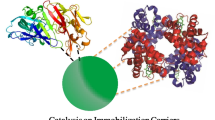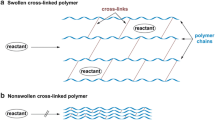Abstract
Protein A affinity chromatography is an important technique that is widely used in purifying polyclonal and monoclonal antibodies. However, improving the IgG loading capacity of protein A affinity materials remains crucial. In this study, a smaller divalent IgG binding molecule derived from the B domain of protein A, i.e., ZZ-domain, was used to develop an affinity adsorbent with high IgG loading capacity by improving the unit area yield of the site-specific immobilization affinity ligand. The engineered ZZ-Cys was tightly immobilized onto Sepharose support via the covalent incorporation of a cysteine handle and a maleimide group, with oriented manner and divalent IgG binding capacity, thereby resulting in homogenous conjugates, namely, Sepharose–ZZSA. Approximately 1.19 mg of ZZ-Cys was coupled onto wet Sepharose g−1 and the maximum saturation binding capacity of Sepharose–ZZSA g−1 was approximately 23.80 mg of IgG. The smaller engineered ZZ-Cys can be produced at a lower cost than protein A and covalently conjugated onto matrix surface with high density and full IgG binding capacity. Thus, the proposed platform may be of general use for IgG purification in an efficient and economical manner.




Similar content being viewed by others
References
Liu HF, Ma J, Winter C, Bayer R (2010) MAbs 2:480–499
Hober S, Nord K, Linhult M (2007) J Chromatogr B Analyt Technol Biomed Life Sci 848:40–47. doi:10.1016/j.jchromb.2006.09.030
Hahn R, Bauerhansl P, Shimahara K, Wizniewski C, Tscheliessnig A, Jungbauer A (2005) J Chromatogr A 1093:98–110. doi:10.1016/j.chroma.2005.07.050
Johnson CP, Jensen IE, Prakasam A, Vijayendran R, Leckband D (2003) Bioconjug Chem 14:974–978. doi:10.1021/bc034063t
Franco EJ, Hofstetter H, Hofstetter O (2006) J Sep Sci 29:1458–1469
Cho IH, Paek EH, Lee H, Kang JY, Kim TS, Paek SH (2007) Anal Biochem 365:14–23. doi:10.1016/j.ab.2007.02.028
Seo MH, Han J, Jin Z, Lee DW, Park HS, Kim HS (2011) Anal Chem 83:2841–2845. doi:10.1021/ac103334b
Yang HM, Bao RM, Cheng YZ, Tang JB (2015) Anal Chim Acta 872:1–6. doi:10.1016/j.aca.2015.03.005
Kang JH, Choi HJ, Hwang SY, Han SH, Jeon JY, Lee EK (2007) J Chromatogr A 1161:9–14. doi:10.1016/j.chroma.2007.05.023
Batalla P, Bolivar JM, Lopez-Gallego F, Guisan JM (2012) J Chromatogr A 1262:56–63. doi:10.1016/j.chroma.2012.08.058
Jung Y, Lee JM, Kim JW, Yoon J, Cho H, Chung BH (2009) Anal Chem 81:936–942. doi:10.1021/ac8014565
Chalker JM, Bernardes GJ, Davis BG (2011) Acc Chem Res 44:730–741. doi:10.1021/ar200056q
Pabst TM, Palmgren R, Forss A, Vasic J, Fonseca M, Thompson C, Wang WK, Wang X, Hunter AK (2014) J Chromatogr A 1362:180–185. doi:10.1016/j.chroma.2014.08.046
Graille M, Stura EA, Corper AL, Sutton BJ, Taussig MJ, Charbonnier JB, Silverman GJ (2000) Proc Natl Acad Sci USA 97:5399–5404
Sjodahl J (1977) Eur J Biochem 78:471–490
Moks T, Abrahmsen L, Nilsson B, Hellman U, Sjoquist J, Uhlen M (1986) Eur J Biochem 156:637–643
Ghose S, Allen M, Hubbard B, Brooks C, Cramer SM (2005) Biotechnol Bioeng 92:665–673. doi:10.1002/bit.20729
Ljungquist C, Jansson B, Moks T, Uhlen M (1989) Eur J Biochem 186:557–561
Ghose S, Zhang J, Conley L, Caple R, Williams KP, Cecchini D (2014) Biotechnol Prog 30:1335–1340. doi:10.1002/btpr.1980
Zimmermann JL, Nicolaus T, Neuert G, Blank K (2010) Nat Protoc 5:975–985. doi:10.1038/nprot.2010.49
Song HY, Zhou X, Hobley J, Su X (2012) Langmuir 28:997–1004. doi:10.1021/la202734f
Lewis JG, Rehm BH (2009) J Immunol Methods 346:71–74. doi:10.1016/j.jim.2009.04.011
Chen C, Huang QL, Jiang SH, Pan X, Hua ZC (2006) Biotechnol Appl Biochem 45:87–92. doi:10.1042/BA20060055
Solomon B, Raviv O, Leibman E, Fleminger G (1992) J Chromatogr 597:257–262
Lao XZ, Zhou YL, Zheng H (2013) Biomed Environ Sci 26:916–919. doi:10.3967/bes2013.021
Tang JB, Sun XF, Yang HM, Zhang BG, Li ZJ, Lin ZJ, Gao ZQ (2013) Anal Chim Acta 776:74–78. doi:10.1016/j.aca.2013.03.017
Steffens GC, Yao C, Prevel P, Markowicz M, Schenck P, Noah EM, Pallua N (2004) Tissue Eng 10:1502–1509. doi:10.1089/ten.2004.10.1502
O’Shannessy DJ, Brigham-Burke M, Peck K (1992) Anal Biochem 205:132–136
Matsumoto I, Seno N, Golovtchenko-Matsumoto AM, Osawa T (1980) J Biochem 87:535–540
Sundberg L, Porath J (1974) J Chromatogr 90:87–98
Rusmini F, Zhong Z, Feijen J (2007) Biomacromolecules 8:1775–1789. doi:10.1021/bm061197b
Acknowledgments
This work was supported by the National Natural Scientific Foundation of China (81201346, 81573717), the Natural Scientific Foundation of Shandong Province (ZR2013HL066, ZR2014BL006, and ZR2015CL014), and National Key Technology R&D Program of the Ministry of Science and Technology (2013GA740103).
Author information
Authors and Affiliations
Corresponding author
Ethics declarations
Conflict of interest
The authors declare that they have no conflict of interest.
Rights and permissions
About this article
Cite this article
Bao, RM., Yang, HM., Yu, CM. et al. Oriented Covalent Immobilization of Engineered ZZ-Cys onto Maleimide-Sepharose: An Affinity Platform for IgG Purification. Chromatographia 79, 1271–1276 (2016). https://doi.org/10.1007/s10337-016-3146-5
Received:
Revised:
Accepted:
Published:
Issue Date:
DOI: https://doi.org/10.1007/s10337-016-3146-5




